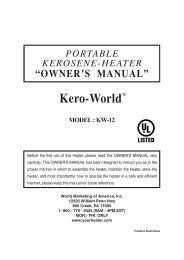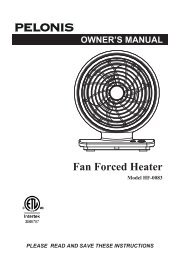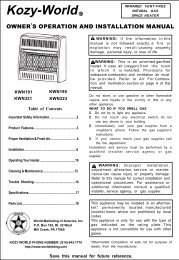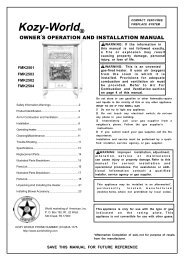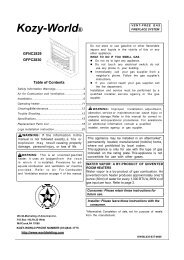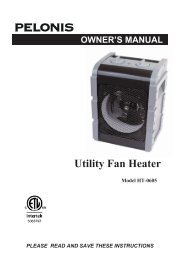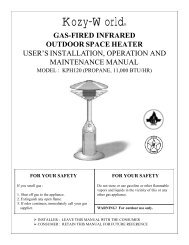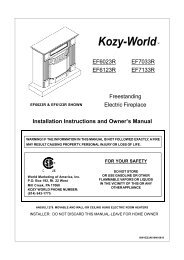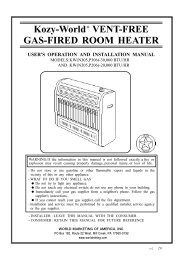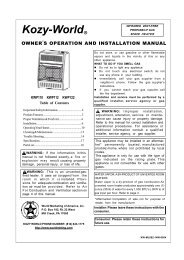GSN2221-GSP2222 - World Marketing of America, Inc.
GSN2221-GSP2222 - World Marketing of America, Inc.
GSN2221-GSP2222 - World Marketing of America, Inc.
You also want an ePaper? Increase the reach of your titles
YUMPU automatically turns print PDFs into web optimized ePapers that Google loves.
Kozy-<strong>World</strong><br />
R<br />
COMPACT LP & NATURAL<br />
GAS VENT-FREE STOVE<br />
OWNER’S OPERATION AND INSTALLATION MANUAL<br />
WARNING: If the information in this<br />
manual is not followed exactly, a fire or explosion<br />
may result causing property<br />
damage, personal injury, or loss <strong>of</strong> life.<br />
GSP3012 GSN3011<br />
GSP3014 GSN3013<br />
<strong>GSP2222</strong> <strong>GSN2221</strong><br />
WARNING: This is an unvented gasfired<br />
heater. It uses air (oxygen) from the<br />
room in which it is installed. Provisions<br />
for adequate combustion and ventilation air<br />
must be provided. Refer to Air For Combustion<br />
and Ventilation section on page 4<br />
<strong>of</strong> this manual.<br />
Do not store or use gasoline or other flammable<br />
vapors and liquids in the vicinity <strong>of</strong> this or any<br />
other appliance.<br />
WHAT TO DO IF YOU SMELL GAS<br />
• Do not try to light any appliance.<br />
• Do not touch any electrical switch; do not use any<br />
phone in your building.<br />
• Immediately call your gas supplier from a neighbor’s<br />
phone. Follow the gas supplier’s instructions.<br />
• If you cannot reach your gas supplier, call the<br />
fire department.<br />
Installation and service must be performed by<br />
a qualified installer, service agency, or local<br />
gas supplier.<br />
WARNING: Improper installation, adjustment,<br />
alteration, service or maintenance can cause injury<br />
or property damage. Refer to this manual for<br />
correct installation and operational procedures. For<br />
assistance or additional information consult a<br />
qualified installer, service agency, or local gas supplier.<br />
This appliance may be installed in an aftermarket*,<br />
permanently located manufactured (mobile) home,<br />
where not prohibited by local codes.This appliance<br />
is only for use with the type <strong>of</strong> gas indicated on the<br />
rating plate. This appliance is not convertible for use<br />
with other gases.<br />
<strong>World</strong> <strong>Marketing</strong> <strong>of</strong> <strong>America</strong>, <strong>Inc</strong>.<br />
P.O. Box 192, Rt. 22 West<br />
Mill Creek, PA 17060<br />
KOZY WORLD PHONE NUMBER: (814) 643-1775<br />
http://www.worldmkting.com<br />
WATER VAPOR:A BY-PRODUCT OF UMVENTED ROOM<br />
HEATERS<br />
Water vaporis a by-product <strong>of</strong> gas combustion.An<br />
unvented room heater produces approximately one(1)<br />
ounce(30) <strong>of</strong> every 1,000BTU’S(3KW’S) <strong>of</strong> gas input per<br />
hour,Refer to papg 6.<br />
Installer : please leave these instructions with<br />
the consumer<br />
Consumer : please retain these instruction for<br />
future use<br />
*Aftermarket: Completion <strong>of</strong> sale, not for purpose <strong>of</strong><br />
resale, from the manufacturer.<br />
1<br />
WM-QL058-03W-0603
Table <strong>of</strong> Contents<br />
Importat Safety information----------2<br />
Air for Combustion & Ventilation---4<br />
Installation---------------------------------6<br />
Installing Blower Accessory--- -----10<br />
Operation Heater------------------------12<br />
Specifications----------------------------14<br />
Troubleshooting---------------------- ---15<br />
Parts Breakdown & Parts List------18<br />
Log Placing Instructions------------22<br />
IMPORTANT SAFETY<br />
INFORMATION<br />
IMPORTANT: Read this<br />
owner’s manual carefully and<br />
completely before trying to<br />
assemble, operate, or service<br />
this heater. Improper use <strong>of</strong><br />
this heater can cause serious<br />
injury or death from burns,<br />
fire, explosion, electrical<br />
shock, and carbon monoxide<br />
poisoning.<br />
DANGER: Carbon monoxide<br />
poisoning may lead to death!<br />
Carbon Monoxide Poisoning:<br />
Early signs <strong>of</strong> carbon monoxide<br />
poisoning resemble the flu, with<br />
headaches, dizziness, or nausea.<br />
If you have these signs, the heater<br />
may not be working properly. Get<br />
fresh air at once! Have heater<br />
serviced. Some people are more<br />
affected by carbon monoxide than<br />
others. These include pregnant<br />
women, people with heart or lung<br />
disease, anemia, those under the<br />
influence <strong>of</strong> alcohol, and those<br />
at high altitudes.<br />
Propane/LP Gas: Propane/LP gas<br />
is odorless. An odor-making agent<br />
is added to Propane/LP gas. The<br />
odor helps you detect a<br />
Propane/LP gas leak. However,<br />
the odor added to Propane/LP gas<br />
can fade. Propane/LP gas may be<br />
present even though no odor<br />
exists.<br />
Natural Gas: Natural gas is odorless.<br />
An odor-making agent is added to<br />
natural gas. The odor helps you<br />
detect a natural gas leak. However, the<br />
odor added to natural gas can<br />
fade. Natural gas may be present<br />
even though no odor exists.<br />
Make certain you read and under<br />
stand all warnings. Keep this<br />
manual for reference. It is your<br />
guide to safe and prope operation<br />
<strong>of</strong> this heater.<br />
WARNING: Any change to<br />
this fireplace or its controls can<br />
be dangerous.<br />
WARNING: Do not allow fans to<br />
blow directly into the heater. Avoid any<br />
drafts that alter burner flame patterns.<br />
Ceiling fans can create drafts that<br />
alter burner flame patterns. Altered<br />
burner patterns can cause sooting.<br />
WARNING: Do not use a blower<br />
insert, heat exchanger insert, or other<br />
accessory not approved for use with<br />
this heater.<br />
Due to high temperatures, the<br />
appliance should be located out <strong>of</strong><br />
traffic and away from furniture<br />
and draperies.<br />
Do not place clothing or other<br />
flammable material on or near the<br />
appliance. Never place any objects<br />
in the fireplace.<br />
Heater becomes very hot when<br />
running fireplace. Keep children and<br />
adults away from hot surfaces to<br />
avoid burns or clothing ignition.<br />
Fireplace will remain hot for a time<br />
after shut<strong>of</strong>f. Allow surfaces to cool<br />
before touching.<br />
Carefully supervise young children<br />
when they are in the room with the<br />
fireplace.<br />
You must operate this heater with<br />
the heater screen in place. Make<br />
sure the heater screen is in place<br />
before running heater.<br />
Keep the appliance area clear and<br />
free from combustible materials,<br />
gasoline, and other flammable<br />
vapors and liquids.<br />
WARNING<br />
Models GSN3011, GSN3013,<br />
<strong>GSN2221</strong> are equipped for Natural<br />
gas. Field conversion is not<br />
permitted.<br />
Models GSP3012, GSP3014,<br />
<strong>GSP2222</strong> are equipped for propane<br />
gas. Field conversion is not<br />
permitted.<br />
1. This appliance is only for use<br />
with the type <strong>of</strong> gas indicated<br />
on the rating plate. This<br />
appliance is not convertible for<br />
use with other gases.<br />
2. Do not place Propane/LP<br />
supply tank(s) inside any<br />
structure. Locate Propane/LP<br />
supply tank(s) outdoors.<br />
3. If you smell gas<br />
• Shut <strong>of</strong>f gas supply.<br />
• Do not try to light any appliance.<br />
• Do not touch any electrical switch:<br />
do not use any phone in your<br />
building.<br />
• Immediately call your gas supplier<br />
from a neighbor’s phone. Follow<br />
the gas supplier’s instructions.<br />
• If you cannot reach your gas<br />
supplier, call the fire department.<br />
4. This heater shall not be installed<br />
in a bedroom or bathroom.<br />
5. Do not use this heater as a<br />
wood-burning heater. Use only<br />
the logs provided with the heater.<br />
6. Do not add extra logs or ornaments<br />
such as pine cones, vermiculite, or<br />
rock wool.Using these added items<br />
can cause sooting. Do not add lava<br />
rock around base. Rock and debris<br />
could fall into the control area <strong>of</strong><br />
heater. After servicing, always<br />
place screen before operating<br />
heater.<br />
7. You must operate this heater with<br />
the heater screen in place. Make<br />
sure heater screen is in place<br />
before running heater.<br />
8. This heater is designed to be<br />
smokeless. If logs ever appear to<br />
smoke, turn heater <strong>of</strong>f and call a<br />
qualified service person. Note:<br />
During initial operation, slight<br />
smoking could occur due to log<br />
curing and heater burning<br />
manufacturing residues.<br />
9. To prevent the creation <strong>of</strong> soot,<br />
follow the instructions in Cleaning<br />
and Maintenance.<br />
10.Turn heater <strong>of</strong>f before using furni<br />
ture polish, wax, carpet cleaner, or<br />
similar products, If heated, the<br />
vapors from these products may<br />
create a white powder residue<br />
within burner box or on adjacent<br />
walls or furniture.<br />
2
SAFETY INFORMATION<br />
Continued<br />
11.This heater needs fresh air<br />
ventilation to run properly. This<br />
heater has an Oxygen Depletion<br />
Sensing (ODS) safety shut<strong>of</strong>f<br />
system. The ODS shuts down the<br />
heater if not enough fresh air is<br />
available. See Air for Combustion<br />
and Ventilation, pages 4 through 5.<br />
If heater keeps shutting <strong>of</strong>f, see<br />
Troubleshooting, pages 15<br />
through 17.<br />
12. Do not run heater:<br />
• Where flammable liquids or vapors<br />
are used or stored.<br />
• Under dusty conditions.<br />
13.Do not use this heater to cook<br />
food or burn paper or other objects.<br />
14. Do not use heater if any part has<br />
been under water. lmmediately call<br />
a qualified service technician to<br />
inspect the room heater and to<br />
replace any part <strong>of</strong> the control<br />
system and any gas control which<br />
has been under water.<br />
15.Turn <strong>of</strong>f and unplug heater<br />
and let cool before servicing. Only<br />
a qualified service person should<br />
service and repair heater.<br />
16. Operating heater above eleva<br />
tions <strong>of</strong> 4,500 feet could cause<br />
pilot outage.<br />
17. Do not operate heater if any log<br />
is broken. Do not operate<br />
heater if a log is chipped (dimesized<br />
or larger).<br />
18. To prevent performance<br />
problems, do not use Propane/<br />
LP fuel tank <strong>of</strong> less than 100<br />
lbs. capacity.<br />
QUALIFIED INSTALLING<br />
AGENCY<br />
Installation and replacement <strong>of</strong> gas<br />
piping, gas utilization equipment or accessories<br />
and repair and servicing <strong>of</strong><br />
equipment shall be performed only by<br />
a qualified agency. The term “qualified<br />
agency” means any individual, firm,<br />
corporation, or company that either in<br />
person or through a representative is<br />
engaged in and is responsible for (a)<br />
the installation, testing, or replacement<br />
<strong>of</strong> gas piping or (b) the connection,<br />
installation, testing, repair, or servicing<br />
<strong>of</strong> equipment; that is experienced in<br />
such work; that is familiar with all pre<br />
cautions required, and that has complied<br />
with all the requirement <strong>of</strong> the<br />
authority having jurisdiction.<br />
PRODUCT FEATURES<br />
SAFETY PILOT<br />
This heater has a pilot with an<br />
Oxygen Depletion Sensing (ODS)<br />
safety shut<strong>of</strong>f system. The ODS/<br />
pilot is a required feature for<br />
vent-free room heaters. The ODS/<br />
pilot shuts <strong>of</strong>f the heater if there<br />
is not enough fresh air.<br />
PIEZO IGNITION SYS-<br />
TEM<br />
This heater has a piezo ignitor.<br />
This system requires no<br />
matches, batteries, or other<br />
sources to light heater.<br />
LOCAL CODES<br />
lnstall and use heater with care.<br />
Follow all local codes. In the<br />
absence <strong>of</strong> local codes, use the<br />
latest edition <strong>of</strong> The National Fuel<br />
Gas Code, ANSZ 223.1, also<br />
known as NFPA 54*.<br />
*Available from:<br />
<strong>America</strong>n National Standards<br />
lnstitute, lnc.<br />
1430 Broadway<br />
New York, NY 10018<br />
National Fire Protection<br />
Association, lnc.<br />
Batterymarch Park<br />
Quincy. MA 02269<br />
This heater is designed for<br />
vent-free operation. State and<br />
local codes in some areas<br />
prohibit the use <strong>of</strong> vent-free<br />
heaters.<br />
State <strong>of</strong> Massachusetts: The installation<br />
must be made by a licensed<br />
plumber or gas fitter in the<br />
Commonwealth <strong>of</strong> Massachusetts.<br />
Sellers <strong>of</strong> unvented propane or natural<br />
gas-fired supplemental room<br />
heaters shall provide to each purchaser<br />
a copy <strong>of</strong> 527 CMR 30 upon<br />
sale <strong>of</strong> the unit.<br />
In the state <strong>of</strong> Massachusetts,<br />
unvented propane or natural gasfired<br />
space heaters shall be prohibited<br />
in bedrooms and bathrooms.<br />
In the State <strong>of</strong> Massachusetts the gas<br />
cock must be a “T” handle type. The<br />
State <strong>of</strong> Massachusetts requires that<br />
a flexible appliance connector cannot<br />
exceed three feet in length.<br />
UNPACKING<br />
1. Remove top inner pack.<br />
2. Tilt carton so that stove is upright.<br />
3. Remove protective side packaging.<br />
4. Slide stove out <strong>of</strong> carton.<br />
5. Remove protective plastic wrap.<br />
6. Remove the two screws in the up<br />
per corners (one on each side),<br />
then lift and pull forward to remove<br />
screen.<br />
7. Remove log set by cutting plasticsties.<br />
8. Carefully unwrap logs.<br />
9. Check for any shipping damage. If<br />
stove or log is damaged, promptly<br />
inform dealer where you bought<br />
stove.<br />
10.Remove legs from inner packing<br />
below heater.<br />
11. Lay heater down on it’s back and<br />
attach legs with fasteners<br />
provided.<br />
PRODUCT IDENTIFICATION<br />
Figure1- Vent Free LP/NG Gas Stove<br />
3
AIR FOR COMBUSTION AND VENTILATION<br />
WARNING: This heater shall not<br />
be installed in a confined space or<br />
unusually tight construction unless<br />
provisions are provided for adequate<br />
combustion and ventilation air. Read<br />
the following instructions to insure<br />
proper fresh air for this and other<br />
fuel-burning appliances in your home.<br />
PROVIDING ADEQUATE<br />
VENTILATION<br />
The following are excerpts from<br />
National Fuel Gas Code, NFPA 54/<br />
ANSZ 223.1,Section 5.3, Air for<br />
Combustion and Ventilation.<br />
All spaces in homes fall into one <strong>of</strong><br />
the three following ventilation<br />
classifications:<br />
1. Unusually Tight Construction<br />
2. Unconfined Space<br />
3. Confined Space<br />
The information on pages 4 through 5<br />
will help you classify your space and<br />
provide adequate ventilation.<br />
Confined and Unconfined Space<br />
The National Fuel Gas Code, ANS<br />
Z223.1 defines a confined space as a<br />
space whose volume is less than 50<br />
cubic feet per 1,000 Btu per hour<br />
(4.8 m 3 per kw) <strong>of</strong> the aggregate<br />
input rating <strong>of</strong> all appliances installed<br />
in that space and an unconfined space<br />
as a space whose volume is not<br />
less than 50 cubic feet per 1,000 Btu<br />
per hour (4.8 m 3 per kw) <strong>of</strong> the aggregate<br />
input rating <strong>of</strong> all appliances installed<br />
in that space. Rooms communicating<br />
directly with the space<br />
in which the appliances are installed*,<br />
through openings not furnished with<br />
doors, are considered a part <strong>of</strong> the<br />
unconfined space.<br />
This heater shall not be installed in<br />
a confined space or unusually tight<br />
construction unless provisions are<br />
provided for adequate combustion<br />
and ventilation air.<br />
* Adjoining rooms are communicating<br />
only if there are doorless passageways<br />
or ventilation grills between<br />
them.<br />
Unusually Tight Construction<br />
The air that leaks around doors and<br />
windows may provide enough fresh<br />
air for combustion and ventilation.<br />
However, in buildings <strong>of</strong> unusually<br />
tight construction, you must provide<br />
additional fresh air.<br />
Unusually tight construction is<br />
defined as construction where:<br />
a) walls and ceilings exposed to the<br />
outside atmosphere have a<br />
continuous water vapor retarder<br />
with a rating <strong>of</strong> one perm (6×10 -11 kg<br />
per pa-sec-m 2 ) or less with<br />
openings gasketed or sealed and<br />
b) weather stripping has been added<br />
on openable windows and doors<br />
and<br />
c) caulking or sealants are applied to<br />
areas such as joints around window<br />
and door frames, between sole<br />
plates and floors, between<br />
wall-ceiling joints, between wall<br />
panels, at penetrations for<br />
plumbing,<br />
electrical, and gas lines, and at<br />
other openings.<br />
If your home meets all <strong>of</strong> the three<br />
criteria above, you must provide<br />
additional fresh air. See Ventilation Air<br />
From Outdoors.<br />
If your home does not meet all <strong>of</strong> the<br />
three criteria above, proceed to<br />
Determining Fresh-Air Flow For<br />
Heater Location.<br />
DETERMINING FRESH-AIR FLOW FOR HEATER LOCATION<br />
Determining if You Have a Confined or Unconfined Space<br />
Use this worksheet to determine if you have a confined or unconfined space.<br />
Space: <strong>Inc</strong>ludes the room in which you will install heater plus any adjoining rooms with doorless passageways<br />
or ventilation grills between the rooms.<br />
1. Determine the volume <strong>of</strong> the space (length×width×height).<br />
Length×Width×Height=<br />
cu.ft. (volume <strong>of</strong> space)<br />
Example: Space size 20ft. (length)×16ft.(width)×8ft. (ceiling height)=2560cu. ft. (volume <strong>of</strong> space)<br />
If additional ventilation to adjoining room is supplied with grills or openings, add the volume <strong>of</strong> these<br />
rooms to the total volume <strong>of</strong> the space.<br />
2. Divide the space volume by 50 cubic feet to determine the maximum Btu/Hr the space can support.<br />
(volume <strong>of</strong> space)÷50 cu. ft.=(Maximum Btu/Hr the space can support)<br />
Example: 2560 cu. ft. (volume <strong>of</strong> space)÷50 cu.ft.=51.2 or 51,200(maximum Btu/Hr the space can support)<br />
4
3. Add the Btu/Hr <strong>of</strong> all fuel burning appliances in the space.<br />
Vent-free heater<br />
Btu/Hr<br />
Gas water heater*<br />
Btu/Hr<br />
Example:<br />
Gas furnace<br />
Btu/Hr Gas water heater 30,000 Btu/Hr<br />
Vented gas heater<br />
Btu/Hr Vent-free heater + 26,000 Btu/Hr<br />
Gas heater logs<br />
Btu/Hr Total = 56,000 Btu/Hr<br />
Other gas appliances* +<br />
Btu/Hr<br />
Total = Btu/Hr<br />
*Do not include direct-vent gas appliances. Direct-vent draws combustion air from the outdoors and<br />
vents to the outdoors.<br />
4. Compare the maximum Btu/Hr the space can support with the actual amount <strong>of</strong> Btu/Hr used.<br />
Btu/Hr (maximum the space can support)<br />
Btu/Hr (actual amount <strong>of</strong> Btu/Hr used)<br />
Example : 51,200 Btu/Hr(maximum the space can support)<br />
56,000 Btu/Hr(actual amount <strong>of</strong> Btu/Hr used)<br />
The space in the above example is a confined space because the actual Btu/Hr used is more than the<br />
maximum Btu/Hr the space can support.<br />
You must provide additional fresh air. Your options are as follows:<br />
A. Rework worksheet, adding the space <strong>of</strong> an adjoining room. If the extra space provides an unconfined<br />
space, remove door to adjoining room or add ventilation grills between rooms. See Ventilation Air From<br />
Inside Building.<br />
B. Vent room directly to the outdoors. See Ventilation Air From Outdoors .<br />
C. Install a lower Btu/Hr heater, if lower Btu/Hr size makes room unconfined.<br />
If the actual Btu/Hr used is less than the maximum Btu/Hr the space can support, the space is an<br />
unconfined space. You will need no additional fresh air ventilation.<br />
WARNING: If the area in which the heater may be operated is smaller than that defined as an unconfined<br />
space or if the building is <strong>of</strong> unusually tight construction, provide adequate combustion and ventilation air by one<br />
<strong>of</strong> the methods described in the National Fuel Gas Code, ANS Z223.1, Section 5.3 or applicable local codes.<br />
Ventilation Air From lnside Building<br />
This fresh air would come from an adjoining unconfined<br />
space. When ventilating to an adjoining unconfined<br />
space, you must provide two permanent openings: one<br />
within 12" <strong>of</strong> the ceiling and one within 12" <strong>of</strong> the floor<br />
on the wall connecting the two spaces (see options 1<br />
and 2, Figure 2). You can also remove door into<br />
adjoining room (see option 3, Figure 2). Follow the<br />
National Fuel Gas Code. NFPA 54/ANS Z223.1, Section<br />
5.3, Air for Combustion and Ventilation for required<br />
size <strong>of</strong> ventilation grills or ducts.<br />
Ventilation Air From Outdoors<br />
Provide extra fresh air by using ventilation grills or ducts.<br />
You must provide two permanent openings: one within<br />
12" <strong>of</strong> the ceiling and one within 12" <strong>of</strong> the floor. Connect<br />
these items directly to the outdoors or spaces open to<br />
the outdoors. These spaces include attics and crawl<br />
spaces. Follow the National Fuel Gas Code, NFPA 54/<br />
ANS Z223.1, Section 5.3, Air for Combustion and Ventilation<br />
for required size <strong>of</strong> ventilation grills or ducts.<br />
IMPORTANT: Do not provide openings for inlet or outlet<br />
air into attic if attic has a thermostat-controlled power vent.<br />
Heated air entering the attic will activate the power vent.<br />
Figure 2 -Ventilation Air from Inside Building<br />
WARNING: Rework worksheet, adding<br />
the space <strong>of</strong> the adjoining unconfined<br />
space. The combined spaces must have<br />
enough fresh air to supply all appliances in<br />
both spaces.<br />
outlet<br />
Figure 3 -Ventilation Air from Outdoors<br />
5
NOTICE: This heater is<br />
intended for use as supplemental<br />
heat. Use this heater along with your<br />
primary heating system. Do not<br />
install this heater as your primary<br />
heat source. If you have a central<br />
heating system, you may run<br />
system's circulating blower while<br />
using heater. This will help circulate<br />
the heat throughout the house . In<br />
the event <strong>of</strong> a power outage, you<br />
can use this heater as your primary<br />
heat source.<br />
INSTALLATION<br />
WARNING: A qualified service<br />
person must install heater. Follow<br />
all local codes.<br />
WARNING: Never install the<br />
heater<br />
• in a bedroom or bathroom<br />
• in a recreational vehicle<br />
• where curtains, furniture, clothing,<br />
or other flammable objects are less<br />
than 42 inches from the front, top, or<br />
sides <strong>of</strong> the heater<br />
• in high traffic areas<br />
• in windy or drafty areas<br />
WARNING: Maintain the<br />
minimum clearances. If you can,<br />
provide greater clearances from<br />
floor, ceiling, and adjoining side and<br />
back walls.<br />
CAUTION: This heater creates<br />
warm air currents. These currents<br />
move heat to wall surfaces next to<br />
heater. Installing heater next to vinyl<br />
or cloth wall coverings or operating<br />
heater where impurities (such as<br />
tobacco smoke, aromatic candles,<br />
cleaning fluids, oil or kerosene<br />
lamps, etc.) in the air exist, may<br />
discolor walls.<br />
Figure 4 -Minimum Clearance to Wall and Ceiling<br />
IMPORTANT: Vent-free heaters add<br />
moisture to the air. Although this is<br />
beneficial, installing heater in rooms<br />
without enough ventilation air may<br />
cause mildew to form from too much<br />
moisture. See Air for Combustion and<br />
Ventilation, pages 4 through 5.<br />
CHECK GAS TYPE<br />
Be sure your gas supply is right for<br />
your heater. Otherwise, call dealer<br />
where you bought the heater for<br />
proper type heater.<br />
WATER VAPOR: A BY-PRODUCT OF UNVENTED ROOM HEATERS<br />
Water vapor: a by-product <strong>of</strong> gas combustion.An unvented room heater productes approximately one(1) ounce<br />
(30ml) <strong>of</strong> water for every 1,000BTU’s (3KW’s) <strong>of</strong> gas input per hour.<br />
Unvented room heaters are recommended as supplemental heat (a room) rather than a primary heat source (an<br />
entire house),in most supplemental heat appllcation,the water vapor does not create a problem,in most<br />
appllcations, the water vapor enhances the low humidity atmosphere experlonce during cold weather.<br />
The following steps will help insure that water vapor does not become a problem,<br />
1.Be sure the heater is sized properly for the appllcation,including ample combusion air and clrculation air.<br />
2.If high humldity is experienced, a dehumldifier may be used to help lower the water vapor content <strong>of</strong> the air.<br />
3.Do not use an unvented room,heater as the primary heat source.<br />
6
CLEARANCES TO COMBUSTIBLES<br />
Carefully follow the instructions below.<br />
This stove is a freestanding unit<br />
designed to set directly on the floor.<br />
IMPORTANT: You must maintain<br />
minimum wall and ceiling clearances<br />
during installation. The minimum<br />
clearances are shown in Figure 4.<br />
Measure from outermost point <strong>of</strong> stove<br />
top.<br />
Minimum Wall and Ceiling Clearances<br />
(see Figure 4)<br />
A. Clearances from outermost point<br />
<strong>of</strong> stove top to any combustible side<br />
wall should not be less than 24<br />
inches.<br />
B. Clearances from outermost point <strong>of</strong><br />
stove top to any combustible back<br />
wall should not be less than 10<br />
inches (lncludes corner<br />
installations).<br />
C. Clearances from the stove top to<br />
the ceiling should not be less than<br />
48 inches.<br />
CONNECTING TO GAS<br />
SUPPLY<br />
WARNING: A qualified service<br />
person must connect heater to gas<br />
supply. Follow all local codes.<br />
CAUTION: Never connect<br />
heater directly to the gas supply.<br />
This heater requires an external<br />
regulator (not supplied). lnstall the<br />
external regulator between the heater<br />
and gas supply.<br />
The installer must supply an external regulator.<br />
The external regulator will reduce incoming gas<br />
pressure. You must reduce incoming gas pressure<br />
to rating inches <strong>of</strong> water. If you do not reduce<br />
incoming gas pressure, heater regulator damage<br />
could occur. lnstall external regulator with the vent<br />
pointing down as shown in Figure 6. Pointing the<br />
vent down protects it from freezing rain or sleet.<br />
Figure 5 -Gas Regulator Location and Gas<br />
Line Access Into Stove Cabinet<br />
Propane/LP<br />
Supply Tank<br />
Figure 6 -External Regulator With<br />
Vent Pointing Down<br />
NG Models:<br />
5”-10.5” W.C.<br />
Gas supplier provides external regulator for natural<br />
gas.<br />
INSTALLATION ITEMS NEEDED<br />
Before installing heater, make sure<br />
you have the items listed below.<br />
• piping (check local codes)<br />
• sealant (resistant to propane/LP<br />
gas)<br />
• equipment shut<strong>of</strong>f valve*<br />
• test gauge connection*<br />
• sediment trap<br />
• tee joint<br />
• pipe wrench<br />
• flexible gas hose.(check local codes)<br />
*A CSA design-certified equipment<br />
shut<strong>of</strong>f valve with 1/8" NPT tap is<br />
an acceptable alternative to test<br />
gauge connection. Purchase the<br />
optional CSA design-certified equipment<br />
shut<strong>of</strong>f valve from your dealer.<br />
See Accessories.<br />
Figure 7 -Gas Connection<br />
* Purchase the optional CSA design-certified equipment shut<strong>of</strong>f valve<br />
from your dealer. See Accessories.<br />
** Minimum inlet pressure for purpose <strong>of</strong> input adjustment.<br />
7<br />
purchase
WARNING: Never connect<br />
heater to private (non-utility) gas<br />
wells. This gas is commonly known<br />
as wellhead gas.<br />
CAUTION: Use only new, black<br />
iron or steel pipe. Internally-tinned<br />
copper tubing may be used in<br />
certain areas. Check your local<br />
codes. Use pipe <strong>of</strong> 1/2" diameter or<br />
greater to allow proper volume gas<br />
to heater. If pipe is too small, undue<br />
loss <strong>of</strong> pressure will occur.<br />
Installation must include an equipment<br />
shut<strong>of</strong>f valve, union, and<br />
plugged 1/8" NPT tap. Locate NPT<br />
tap within reach for test gauge hook<br />
up. NPT tap must be upstream from<br />
heater (see Figure 7).<br />
IMPORTANT: Install equipment<br />
shut<strong>of</strong>f valve in an accessible<br />
location. The equipment shut<strong>of</strong>f<br />
valve is for turning on or shutting<br />
<strong>of</strong>f the gas to the appliance. Apply<br />
pipe joint sealant lightly to male<br />
threads.This will prevent excess<br />
sealant from going into pipe. Excess<br />
sealant in pipe could result in<br />
clogged heater valves.<br />
CAUTION: Use pipe joint<br />
sealant that is resistant to gas<br />
(PROPANE or NG).<br />
CAUTION: Avoid damage to<br />
regulator. Hold gas regulator with<br />
wrench when connecting into gas<br />
piping and/or fittings.<br />
CHECKING GAS<br />
CONNECTIONS<br />
WARNING: Test all gas piping<br />
and connections for leaks after<br />
installing or servicing. Correct all<br />
leaks at once.<br />
WARNING: Never use an<br />
open flame to check for a leak.<br />
Apply a mixture <strong>of</strong> liquid soap and<br />
water to all joints. Bubbles forming<br />
show a leak. Correct all leaks at<br />
once.<br />
CAUTION: Make sure external<br />
regulator has been installed between<br />
gas supply and heater. See guidelines<br />
under Connecting to Gas<br />
Supply.<br />
Figure 8 -Equipment Shut<strong>of</strong>f Valve<br />
Pressure Testing Gas<br />
Supply Piping System<br />
Test Pressures In Excess Of 1/2<br />
PSIG(3.5kPa)<br />
1. Disconnect heater with its<br />
appliance main gas valve (control<br />
valve) and equipment shut<strong>of</strong>f valve<br />
from gas supply piping system.<br />
Pressures in excess <strong>of</strong> 1/2 PSIG<br />
will damage heater regulator.<br />
2. Cap <strong>of</strong>f open end <strong>of</strong> gas pipe<br />
where equipment shut<strong>of</strong>f valve<br />
was connected.<br />
3. Pressurize supply piping system<br />
by either using compressed air or<br />
opening gas supply tank valve.<br />
4. Check all joints <strong>of</strong> gas supply<br />
piping system. Apply mixture <strong>of</strong><br />
liquid soap and water to gas<br />
joints. Bubbles forming show a<br />
leak.<br />
5. Correct all leaks at once.<br />
6. Reconnect heater and equipment<br />
shut<strong>of</strong>f valve to gas supply. Check<br />
reconnected fittings for leaks.<br />
Pressure Testing Heater<br />
Gas Connections<br />
1. Open equipment shut<strong>of</strong>f valve<br />
(see Figure 8).<br />
We recommend that you install a<br />
sediment trap in supply line as shown<br />
in Figure 7. Locate sediment trap<br />
where it is within reach for cleaning.<br />
Install in piping system between fuel<br />
supply and heater. Locate sediment<br />
trap where trapped matter is not likely<br />
to freeze. A sediment trap traps<br />
moisture and contaminants. This<br />
keeps them from going into heater<br />
controls. If sediment trap is not<br />
installed or is installed incorrectly,<br />
heater may not run properly.<br />
Figure 9.1 -Checking Gas Joints<br />
8
2. Open gas supply tank valve.<br />
3. Make sure control knob <strong>of</strong> heater is<br />
in the OFF position.<br />
4. Check all joints from equipment<br />
shut<strong>of</strong>f valve to control valve<br />
(LP GAS see Figure 9.1 NATURAL<br />
GAS see Figure 9.2). Apply<br />
mixture <strong>of</strong> liquid soap and water<br />
to gas joints. Bubbles forming<br />
show a leak.<br />
5. Correct all leaks at once.<br />
6. Light heater (see Operating<br />
Heater). Check all other internal<br />
joints for leaks.<br />
7. Turn <strong>of</strong>f heater (see To Turn Off<br />
Gas Appliance).<br />
Test Pressures Equal To or<br />
Less Than 1/2 PSIG(3.5 kPa)<br />
1. Close equipment shut<strong>of</strong>f valve<br />
(see Figure 8).<br />
2. Pressurize supply piping system<br />
by either using compressed air or<br />
opening natural supply tank<br />
valve.<br />
3. Check all joints from gas meter to<br />
equipment shut<strong>of</strong>f valve(see<br />
Figure 9). Apply mixture <strong>of</strong> liquid<br />
soap and water to gas joints.<br />
Bubbles forming show a leak.<br />
4. Correct all leaks at once.<br />
It is very important to install the logs<br />
exactly as instructed. Do not modify<br />
logs. Only use logs supplied with<br />
heater.<br />
IMPORTANT: Make sure log does<br />
not cover any burner ports (see Figure<br />
10).<br />
Also, see log placing instructions.<br />
Figure 10 -Installing Log Set (Top View)<br />
INSTALLATION INSTRUCTIONS FOR LOG<br />
PLACEMENT<br />
1. LOGS<br />
FIG(1)<br />
STEP 1: Install log 1 on the<br />
left rear bracket .<br />
STEP 3: Install log 3 into slots on<br />
the front bracket .<br />
FIG(4)<br />
STEP 4: Place recessed hole on the<br />
bottom part <strong>of</strong> log 5 onto the pin on log<br />
2. Place the lower part <strong>of</strong> log 5 on the flat<br />
area at the right side <strong>of</strong> log 3 .<br />
Figure 9.2 -Checking Gas Joints<br />
WARNING: Failure to position<br />
the parts in accordance with these<br />
diagrams or failure to use only parts<br />
specifically approved with this heater<br />
may result in property damage or<br />
personal injury.<br />
CAUTION: After installation and<br />
periodically thereafter, check to ensure<br />
that no flame comes in<br />
contact with any log. With the heater<br />
set to High, check to see if flames<br />
contact any log. If so, reposition logs<br />
according to the log installation<br />
instructions in this manual. Flames<br />
FIG(2)<br />
STEP 2: Install log 2 on the<br />
right rear bracket .<br />
FIG(3)<br />
FIG(5)<br />
STEP 5: Place recessed hole on the<br />
bottom part <strong>of</strong> log 4 onto the pin on log<br />
1. Place the lower part <strong>of</strong> log 4 on<br />
the flat area at the left side <strong>of</strong> log 3 .<br />
9<br />
FIG(6)
Installing Blower Accessory<br />
BLOWER ACCESSORY 20-6028 FOR GSN3011,GSP3012 ,GSN3013,GSP3014<br />
Remove the 3 screws from the<br />
back, upper right hand corner or<br />
the stove. Set these screws<br />
aside.<br />
Attach the Black L shaped<br />
Bracket (Packed with the Stove)<br />
to the back, upper corner using<br />
2 <strong>of</strong> the screws previously<br />
removed.<br />
Attach the Switch Box to the<br />
Bracket using the screws<br />
provided.<br />
Next, remove the small rectangular<br />
Panel on the back <strong>of</strong> the<br />
stove (6 screws)<br />
Attach the Temperature Sensor<br />
to the 2 pre-drilled holes on the<br />
inside, right top <strong>of</strong> the internal<br />
firebox, using the 2 Black Screws<br />
provided.<br />
Attach the Fan unit to the Two<br />
Silver Brackets on the Back<br />
Panel that was removed in Step<br />
3. (4 silver screws)<br />
Run the wires from the Switch<br />
Box through the hole on this Back<br />
Panel.<br />
Connect the 2 Yellow Wires from<br />
the Switch Box to the 2 Terminals<br />
on the Temperature Sensor.<br />
Connect the Green Wire from<br />
the Fan to the Green Wire from<br />
the Switch Box.<br />
Connect the one <strong>of</strong> the Black<br />
Wires from the fan to the Black<br />
Wire from the Switch Box and the<br />
other Black Wire to the White<br />
And 20-6029 FOR <strong>GSN2221</strong>,<strong>GSP2222</strong><br />
Wire. (Make sure these wires are<br />
clear <strong>of</strong> the fan.)<br />
Reattach the Back Panel using<br />
the 6 screws removed earlier.<br />
Attach the Round Switch Box<br />
cover to the Back Panel using the<br />
3 screws provided.<br />
Plug the 3 prong grounded plug<br />
into a nearby outlet.<br />
Your blower is now available for<br />
use. You can run it in manual<br />
mode by simply turning the switch<br />
from the middle position (OFF) to<br />
Manual. The fan will operate until<br />
you turn it <strong>of</strong>f. Alternately you can<br />
turn it to the Thermostat position.<br />
In this case the fan will turn on<br />
when the sensor warms from the<br />
flame being on. It will turn <strong>of</strong>f as<br />
the sensor cools after the flame<br />
has been <strong>of</strong>f for awhile.<br />
WARNING: 1. ELECTRICAL GROUND-<br />
ING INSTRUCTIONS: This appliance is<br />
equipped with a three-prong grounding<br />
plug for your protection against<br />
shock hazard and should be plugged<br />
directly into a properly grounded<br />
three-prong receptacle.<br />
2. Do not let the wires touch the reflect<br />
panel <strong>of</strong> the firebox, let the wires<br />
<strong>of</strong> the motor and green wire through<br />
the hole <strong>of</strong> the Knock-out panel.<br />
NOTICE: Shut <strong>of</strong>f gas heater during<br />
the following blower<br />
installation.<br />
Figure 11-F -Removing<br />
stove Knock-out panel<br />
Figure 12-F -Removing<br />
stove Knock-out panel<br />
Figure 13-F -Attaching<br />
Brackets To Blower<br />
10
Installing Blower Accessory<br />
BLOWER ACCESSORY 20-6028 OR 20-6029<br />
Figure 14 -F Routing Power Cord<br />
Figure 15 -F Mounting Blower And Installing<br />
Blower Control Housing<br />
11
OPERATING HEATER<br />
FOR YOUR SAFETY<br />
READ BEFORE LIGHTING<br />
WARNING: If you do not<br />
follow these instructions exactly, a<br />
fire or explosion may result causing<br />
property damage, personal injury or<br />
loss <strong>of</strong> life.<br />
A. This appliance has a pilot which<br />
must be lighted by hand. When<br />
lighting the pilot, follow these<br />
instructions exactly.<br />
B. Before lighting smell all<br />
around the appliance area for<br />
gas. Be sure to smell next to the<br />
floor because some gas is<br />
heavier than air and will settle<br />
on the floor.<br />
WHAT TO DO IF YOU SMELL GAS<br />
• Do not try to light any appliance.<br />
• Do not touch any electrical switch;<br />
do not use any phone in your<br />
building.<br />
• Immediately call your gas<br />
supplier from a neighbor's<br />
phone. Follow the gas supplier's<br />
instructions.<br />
• If you cannot reach your gas<br />
supplier, call the fire department.<br />
C. Use only your hand to push in or<br />
turn the gas control knob. Never<br />
use tools. If the knob will not push<br />
in or turn by hand, don't try to<br />
repair it. Call a qualified service<br />
technician or gas supplier. Force<br />
or attempted repair may result<br />
in a fire or explosion.<br />
D. Do not use this appliance if any<br />
part has been under water.<br />
Immediately call a qualified<br />
service technician to inspect the<br />
appliance and to replace any<br />
part <strong>of</strong> the control system<br />
and any gas control which has<br />
been under water.<br />
LIGHTING<br />
INSTRUCTION<br />
NOTICE: During initial operation <strong>of</strong><br />
new heater, burning logs will give<br />
<strong>of</strong>f a paper-burning smell. Orange<br />
flame will also be present. Open a<br />
window to vent smell. This will only<br />
last a few hours.<br />
1. STOP! Read the safety information,<br />
page 12, column1.<br />
2. Make sure equipment shut<strong>of</strong>f<br />
valve is fully open.<br />
3. Open right side door throught the<br />
slot at the back. then you can see<br />
control knob and ignitor button<br />
(see Figure 16)<br />
4. Turn control knob clockwise<br />
to the OFF position.<br />
5. Wait five (5) minutes to clear out<br />
any gas. Then smell for gas,<br />
including near the floor. If you<br />
smell gas, STOP! Follow "B" in<br />
the safety information, page 12,<br />
column 1. If you don't smell<br />
gas, go to the next step.<br />
6. Turn control knob counterclock<br />
wise to the PIILOT position.<br />
Press in control knob for five (5)<br />
seconds (see Figure 17).<br />
• Note: You may be running this<br />
heater for the first time after<br />
hooking up to gas supply. If so,<br />
the control knob may need to<br />
be pressed in for 30 seconds<br />
or less. This will allow air to<br />
bleed from the gas system.<br />
7. With control knob pressed in,<br />
press and release ignitor button.<br />
This will light pilot. The pilot is<br />
attached to the front burner. If<br />
needed, keep pressing ignitor<br />
button until pilot lights.<br />
Note: If pilot does not stay lit,<br />
contact a qualified service<br />
person or gas supplier for<br />
repairs. Until repairs are made,<br />
light pilot with match. To light<br />
pilot with match, see Manual<br />
Lighting Procedures.<br />
8. Keep control knob pressed in for<br />
30 seconds after lighting pilot.<br />
After 30 seconds release<br />
control knob.<br />
• If control knob does not pop<br />
out when released, contact a<br />
qualified service person or gas<br />
supplier for repairs.<br />
Note: If pilot goes out, repeat<br />
steps 3 through 7. This heater<br />
has a safety interlock system.<br />
Wait one (1) minute for system<br />
to reset before lighting pilot again.<br />
9. Turn control knob counterclockwise<br />
to desired heating<br />
level. The burners should light.<br />
Set control knob to any heat level<br />
between HI and LO.<br />
Figure 18 -Pilot<br />
CAUTION: Do not try to adjust<br />
heating levels by using the<br />
equipment shut<strong>of</strong>f valve.<br />
TO TURN OFF GAS<br />
TO APPLIANCE<br />
Shutting Off Heater<br />
Turn control knob clockwise to<br />
the OFF position.<br />
Shutting Off Burners Only (Pilot<br />
stays lit)<br />
Turn control knob clockwise to<br />
the PILOT position.<br />
Figure 16 -Control Knob and<br />
Ignitor Button Location<br />
Figure 17-Open right side door throught the<br />
slot at the back<br />
12
THERMOSTAT CONTROL<br />
OPERATION<br />
The thermostat control knob can be<br />
set to any comfort level between HI<br />
and LO. The thermostat will gradually<br />
modulate the heat output and flame<br />
height from higher to lower settings,<br />
or pilot, in order to maintain the<br />
comfort level you select. The ideal<br />
comfort setting will vary by household<br />
depending upon the amount <strong>of</strong> space<br />
to be heated, the output <strong>of</strong> the<br />
central heating system, etc.<br />
Note: Selecting the Hi setting with<br />
the control knob will cause the<br />
burners to remain fully on, without<br />
modulating down in most cases.<br />
MANUAL LIGHTING<br />
PROCEDURE<br />
1. Follow steps 1 through 5 under<br />
lighting instruction.<br />
2. Depress control knob and light<br />
pilot with match.<br />
3. Keep control knob pressed in<br />
for 30 seconds after lighting<br />
pilot. After 30 seconds, release<br />
control knob. Now follow<br />
Step 8.<br />
INSPECTING BURNERS<br />
Check pilot flame pattern and<br />
burner flame patterns <strong>of</strong>ten.<br />
PILOT FLAME PATTERN<br />
Figure 20 shows a correct pilot<br />
flame pattern. Figure 21 shows an<br />
incorrect pilot flame pattern. The<br />
incorrect pilot flame is not touching<br />
the thermocouple.This will cause the<br />
thermocouple to cool. When the<br />
thermocouple cools, the heater<br />
will shut down. If pilot flame pattern is<br />
incorrect, as shown in Figure 21.<br />
• Turn heater <strong>of</strong>f (see TO TURN<br />
OFF GAS TO APPLIANCE)<br />
• see troubleshooting<br />
Figure 19 -Correct Pilot Flame<br />
Pattern<br />
Figure 20 -<strong>Inc</strong>orrect Pilot Flame<br />
Pattern<br />
BURNER FLAME PATTERN<br />
Figure 21 shows a correct burner<br />
flame pattern. Figure 22 shows an<br />
incorrect burner flame pattern. If<br />
burner flame is incorrect:<br />
• Turn heater <strong>of</strong>f (see TO TURN<br />
OFF GAS TO APPLIANCE)<br />
• See troubleshooting<br />
Figure 21-Correct Flame Pattern<br />
with Control Knob Set to High Flame<br />
Figure 22 -<strong>Inc</strong>orrect Flame Pattern<br />
with Control Knob Set to High Flame<br />
CLEANING AND<br />
MAINTENANCE<br />
WARNING: Turn <strong>of</strong>f heater and<br />
let cool before cleaning.<br />
CAUTION: You must keep<br />
control areas, burner, and<br />
circulating air passageways <strong>of</strong><br />
heater clean. Inspect these<br />
areas <strong>of</strong> heater before each<br />
use. Have heater inspected<br />
yearly by a qualified service person.<br />
Heater may need more<br />
frequent cleaning due to<br />
excessive lint from carpeting,<br />
bedding material, pet hair, etc.<br />
13<br />
CLEANING BURNER<br />
INJECTOR HOLDER AND<br />
PILOT AIR INLET HOLE<br />
The primary air inlet holes allow the<br />
proper amount <strong>of</strong> air to mix with the<br />
gas. This provides a clean burning<br />
flame. Keep these holes clear <strong>of</strong> dust,<br />
dirt, lint, and pet hair. Clean these air<br />
inlet holes prior to each heating season.<br />
Blocked air holes will create soot. We<br />
recommend that you clean the unit<br />
every three months during operation<br />
and have heater inspected yearly by a<br />
qualified service person.<br />
We also recommend that you keep<br />
the burner tube and pilot assembly<br />
clean and free <strong>of</strong> dust and dirt. To<br />
clean these parts we recommend<br />
using compressed air no greater<br />
than 30 PSI. Your local computer<br />
store, hardware store, or home<br />
center may carry compressed air in<br />
a can. You can use a vacuum<br />
cleaner in the blow position. If<br />
using compressed air in a can,<br />
please follow the directions on the<br />
can. If you don't follow directions<br />
on the can, you could damage the<br />
pilot assembly.<br />
1. Shut <strong>of</strong>f the unit, including the<br />
pilot. Allow the unit to cool for<br />
at least thirty minutes.<br />
2. Inspect burner, pilot and<br />
primary air inlet holes on<br />
injector holder for dust and dirt<br />
(See Figure 24).<br />
3. Blow air through the<br />
ports/slots and holes in the<br />
burner.<br />
4. Check the injector holder<br />
located at the end <strong>of</strong> the<br />
burner tube again. Remove<br />
any large particles <strong>of</strong> dust, dirt,<br />
lint, or pet hair with a s<strong>of</strong>t cloth<br />
or vacuum cleaner nozzle.<br />
5. Blow air into the primary air<br />
holes on the injector holder.<br />
6. In case any large clumps <strong>of</strong><br />
dust have now been pushed<br />
into the burner repeat steps 3<br />
and 4.<br />
Clean the pilot assembly also. A<br />
yellow tip on the pilot flame<br />
indicates dust and dirt in the pilot<br />
assembly. There is a small pilot air<br />
inlet hole about two inches from<br />
where the pilot flame comes out <strong>of</strong><br />
the pilot assembly (see Figure 25).<br />
With the unit <strong>of</strong>f, lightly blow air<br />
through the air inlet hole. You may<br />
blow through a drinking straw if<br />
compressed air is not available.
Figure 23 -Injector Holder on Outlet<br />
Burner Tube<br />
Burner<br />
Figure 24-Pilot Inlet Air Hole<br />
MAIN BURNER<br />
Periodically inspect all burner flame<br />
holes with the heater running. All<br />
slotted burner flame holes should<br />
be open with yellow flame present. All<br />
round burner flame holes should be<br />
open with a small blue flame<br />
present. Some burner flame holes<br />
may become blocked by debris or<br />
rust, with no flame present. If so,<br />
turn <strong>of</strong>f heater and let cool. Either<br />
remove blockage or replace burner.<br />
Blocked burner flame holes will<br />
create soot.<br />
SPECIFICATIONS<br />
<strong>GSN2221</strong> <strong>GSP2222</strong><br />
Btu(Variable) 20000/22,000BTU/H<br />
Gas Type (<strong>GSN2221</strong>) Natural<br />
(<strong>GSP2222</strong>) Propane/LP<br />
Ignition Piezo<br />
<strong>GSP2222</strong> Model<br />
Manifold Pressure 8.0"W.C.<br />
Inlet Gas Pressure<br />
(In. <strong>of</strong> water)*<br />
Maximum 14"<br />
Minimum 11"<br />
<strong>GSN2221</strong> Model<br />
Manifold Pressure 3.0"W.C.<br />
Inlet Gas Pressure<br />
(In. <strong>of</strong> water)*<br />
Maximum 10.5"<br />
Minimum 5"<br />
Dimensions, <strong>Inc</strong>hes (H×W×D)<br />
Stove 23 5/8"×27 1/2” ×11 1/2"<br />
Carton 28"×29 1/2” ×13 3/4”<br />
Weight, pounds<br />
Stove<br />
58 lbs.<br />
Shipping<br />
67 lbs.<br />
GSN3011 GSP3012<br />
GSN3013 GSP3014<br />
Btu(Variable) 20000/30,000BTU/H<br />
Gas Type (GSN3011 & GSN3013)<br />
NATURAL<br />
(GSP3012 & GSP3014)<br />
Propane/LP<br />
Ignition Piezo<br />
GSP3012 & GSP3014 Models<br />
Manifold Pressure 8.0"W.C.<br />
Inlet Gas Pressure<br />
(In. <strong>of</strong> water)*<br />
Maximum 14"<br />
Minimum 11"<br />
GSN3011 & GSN3013 Models<br />
Manifold Pressure 3.0"W.C.<br />
Inlet Gas Pressure<br />
(In. <strong>of</strong> water)*<br />
Maximum 10.5"<br />
Minimum 5"<br />
Dimensions, <strong>Inc</strong>hes (H×W×D)<br />
Stove 25 4/5"×32 1/4” ×13"<br />
Carton 25 1/8"×34 1/8” ×12 7/8”<br />
Weight, pounds<br />
Stove<br />
74 lbs.<br />
Shipping<br />
83 lbs.<br />
*For purposes <strong>of</strong> input adjustment<br />
CABINET<br />
Air Passageways<br />
• Use a vacuum cleaner or<br />
pressurized air to clean.<br />
Exterior<br />
• Use a s<strong>of</strong>t cloth dampened with a<br />
mild soap and water mixture. Wipe<br />
the cabinet to remove dust.<br />
LOGS<br />
• If you remove logs for cleaning,<br />
refer to Installing Logs to properly<br />
replace logs.<br />
• Replace logs if broken or chipped<br />
(dimesized or larger).<br />
REPLACEMENT PARTS NOTE:<br />
Use only original replacement<br />
parts. This will protect your warranty<br />
coverage for parts replaced under<br />
warranty.<br />
PARTS UNDER WARRANTY<br />
Contact authorized dealers <strong>of</strong> this<br />
product. If they can't supply original<br />
replacement part(s) call the number<br />
on the back <strong>of</strong> manual. when<br />
contacting your dealer or <strong>World</strong><br />
<strong>Marketing</strong>,<br />
have ready:<br />
• Your name<br />
• Your address<br />
• Model and serial numbers<br />
<strong>of</strong> your heater<br />
• How heater was malfunctioning •<br />
Type <strong>of</strong> gas used (propane/LP or<br />
NG)<br />
• Purchase date<br />
• Usually, we will ask you to<br />
return the defective part to the<br />
factory.<br />
• Warranty card.<br />
PARTS NOT UNDER<br />
WARRANTY<br />
Contact authorized dealers <strong>of</strong> this<br />
product or Parts Central. If they can’t<br />
supply original replacement part(s) call<br />
<strong>World</strong> <strong>Marketing</strong>’s t number on the<br />
front page.<br />
ACCESSORIES<br />
Purchase these heater accessories<br />
from your local dealer or Parts<br />
Central. This part is not currently<br />
available from <strong>World</strong> <strong>Marketing</strong>.<br />
EQUIPMENT SHUTOFF VALVE-<br />
Equipment shut<strong>of</strong>f valve with 1/8"<br />
NPT tap.<br />
FLEXILBE GAS HOSE<br />
Flexilbe gas hose is used for connecting<br />
the heater to gas supply.<br />
the flexilbe hose must be CSA<br />
Approved.<br />
14
Note: All troubleshooting items<br />
are listed in order <strong>of</strong> operation.<br />
OBSERVED PROBLEM<br />
No spark when ignition button is<br />
pressed<br />
ODS/pilot lights but flame goes<br />
out when control knob is<br />
released.<br />
Spark at ODS/pilot but<br />
no ignition.<br />
TROUBLESHOOTING<br />
WARNING: Only a qualified<br />
service person should service<br />
and repair heater.<br />
POSSIBLE CAUSE<br />
1. Ignitor electrode is positioned<br />
wrong.<br />
2. Ignitor electrode is broken.<br />
3. Ignitor electrode is not connected<br />
to ignitor cable.<br />
4. Ignitor cable is pinched or wet.<br />
5. Broken ignitor cable.<br />
6. Bad piezo ignitor.<br />
7. Piezo ignitor nut is loose.<br />
1. Gas supply is turned <strong>of</strong>f or<br />
equipment shut<strong>of</strong>f valve is closed.<br />
2. Control knob is not fully pressed in<br />
while in PILOT position.<br />
3. Air in gas lines when installed.<br />
4. ODS/pilot is clogged.<br />
5. Gas regulator setting is not correct.<br />
6. Control knob not in PILOT position.<br />
7. Depleted gas supply.<br />
1. Control knob is not fully pressed in.<br />
2. Control knob is not pressed in<br />
long enough.<br />
3. Safety interlock system has been<br />
triggered.<br />
4. Equipment shut<strong>of</strong>f valve is not<br />
fully open.<br />
5. Thermocouple connection is loose<br />
at control valve.<br />
6. Pilot flame is not touching<br />
thermocouple, which allows<br />
thermocouple to cool and causing<br />
pilot flame to go out. This<br />
problem could be caused by<br />
one or both <strong>of</strong> the following:<br />
A) Low gas pressure.<br />
B) Dirty or partially clogged<br />
ODS/pilot.<br />
7. Thermocouple damaged.<br />
8. Control valve damaged.<br />
15<br />
CAUTION: Never use a wire,<br />
needle, or similar object to<br />
clean ODS/pilot. This can<br />
damage ODS/pilot unit.<br />
REMEDY<br />
1. Replace ignitor.<br />
2. Replace ignitor.<br />
3. Reconnect ignitor cable.<br />
4. Free ignitor cable if pinched<br />
by any metal or tubing. Keep<br />
ignitor cable dry.<br />
5. Replace ignitor cable.<br />
6. Replace control valve ( piezo<br />
is part <strong>of</strong> control valve).<br />
7. Tighten nut holding piezo<br />
ignitor to base panel <strong>of</strong> log<br />
set. Nut is located behind base<br />
panel.<br />
1. Turn on gas supply or open<br />
equipment shut<strong>of</strong>f valve.<br />
2. Fully press in control knob while<br />
pressing ignitor button.<br />
3. Continue holding down control<br />
knob. Repeat igniting operation<br />
until air is removed.<br />
4. Clean ODS/pilot (see Cleaning<br />
and Maintenance) or replace<br />
ODS/pilot assembly.<br />
5. Replace gas regulator<br />
6. Turn control knob to pilot<br />
position.<br />
7. Replace gas regulator.<br />
1. Press in control knob fully.<br />
2. After ODS/pilot lights, keep<br />
control knob pressed in 30<br />
seconds.<br />
3. Wait one minute for safety<br />
interlock system to reset.<br />
Repeat ignition operation.<br />
4. Fully open equipment shut<strong>of</strong>f<br />
valve.<br />
5. Hand tighten until snug, then<br />
tighten 1/4 turn more.<br />
6. A) Contact local natural or propane/LP<br />
gas company.<br />
B) Clean ODS/pilot (see Cleaning<br />
and Maintenance) or replace<br />
ODS/pilot assembly.<br />
7. Replace thermocouple.<br />
8. Replace control valve.
OBSERVED PROBLEM<br />
Burner(s) does not light after<br />
ODS/pilot is lit.<br />
TROUBLESHOOTING<br />
Continued<br />
POSSIBLE CAUSE<br />
1. Burner orifice is clogged.<br />
2. Burner orifice diameter is too<br />
small.<br />
3. Inlet gas pressure is too low.<br />
REMEDY<br />
1. Clean burner orifice (see Cleaning<br />
and Maintenance) or replace<br />
burner orifice.<br />
2. Replace burner orifice.<br />
3. Contact local natural or propane/<br />
LP gas company.<br />
Delayed ignition <strong>of</strong> burner(s).<br />
Burner backfiring during combustion.<br />
Yellow flame during burner<br />
combustion.<br />
1. Manifold pressure is too low.<br />
2. Burner orifice is clogged.<br />
1. Burner orifice is clogged or<br />
damaged.<br />
2. Burner is damaged.<br />
3. Gas regulator is defective.<br />
1. Not enough air.<br />
2. Gas regulator is defective.<br />
1. Contact local natural or<br />
propane/LP gas company.<br />
2. Clean burner (see Cleaning and<br />
Maintenance) or replace<br />
burner orifice.<br />
1. Clean burner orifice (see Clean<br />
ing and Maintenance ) or replace<br />
burner.<br />
2. Replace burner.<br />
3. Replace gas regulator.<br />
1. Check burner for dirt and debris. If<br />
found, clean burner (see Cleaning<br />
and Maintenance).<br />
2. Replace gas regulator.<br />
Slight smoke or odor during<br />
initial operation.<br />
1. Residues from manufacturing<br />
processes.<br />
1. Problem will stop after a few hours<br />
<strong>of</strong> operation.<br />
Heater produces a whistling noise<br />
when the burner is lit.<br />
White powder residue forming<br />
within burner box or on adjacent<br />
walls or furniture.<br />
1. Turning control knob to Hl position<br />
when burner is cold.<br />
2. Air is in the gas line.<br />
3. Air passageways on the heater<br />
are blocked.<br />
4. Dirty or partially clogged burner<br />
orifice.<br />
1. When heated, vapors from<br />
furniture polish, wax, carpet<br />
cleaners, etc. turn into a white<br />
powder residue.<br />
1. Turn control knob to LO position<br />
and let warm up for a minute.<br />
2. Operate burner until air is removed<br />
from line. Have gas line checked<br />
by local natural or propane/LP<br />
gas company.<br />
3. Observe minimum installation<br />
clearances.<br />
4. Clean burner (see Cleaning and<br />
Maintenance) or replace burner<br />
orifice.<br />
1. Turn heater <strong>of</strong>f when using<br />
furniture polish, wax, carpet<br />
cleaner or similar products.<br />
16
TROUBLESHOOTING<br />
Continued<br />
WARNING: If you smell gas<br />
• Shut <strong>of</strong>f gas supply.<br />
• Do not try to light any appliance.<br />
• Do not touch any electrical switch; do not use any phone in your building.<br />
• Immediately call your gas supplier from a neighbor’s phone. Follow the gas<br />
supplier’s instructions.<br />
• If you cannot reach your gas supplier, call the fire department.<br />
IMPORTANT: Operating heater where impurities in the air exist may create odors.<br />
Cleaning supplies, paint, paint remover, cigarette smoke, cements and glues, new<br />
carpet or textiles, etc, create fumes. These fumes may mix with combustion air and<br />
create odors.<br />
OBSERVED PROBLEM<br />
Heater produces a clicking/ticking<br />
noise just after burner is lit or shut<br />
<strong>of</strong>f.<br />
POSSIBLE CAUSE<br />
1. Metal is expanding while heating<br />
or contracting while cooling.<br />
REMEDY<br />
1. This is common with most<br />
heaters. If noise is excessive,<br />
contact a qualified service person.<br />
Heater produces unwanted odors.<br />
Heater shuts <strong>of</strong>f in use (ODS<br />
operates).<br />
Gas odor even when control knob is<br />
in OFF position.<br />
1. Heater is burning vapors from<br />
paint, hair spray, glues, etc.<br />
(See IMPORTANT statement<br />
above).<br />
2. Gas leak. See Warning<br />
Statement at top <strong>of</strong> page.<br />
1. Not enough fresh air is<br />
available.<br />
2. Low line pressure.<br />
3. ODS/pilot is partially clogged.<br />
1. Gas leak. See Warning<br />
Statement at top <strong>of</strong> page.<br />
2. Control valve is defective.<br />
1. Ventilate room. Stop using odor<br />
causing products while heater<br />
is running.<br />
2. Locate and correct all leaks(see<br />
Checking Gas Connections).<br />
1. Open a window and/or door for<br />
ventilation.<br />
2. Contact a local natural or<br />
Propane/LP gas company.<br />
3. Clean ODS/pilot.<br />
1. Locate and correct all leaks<br />
(see Checking Gas<br />
Connections).<br />
2. Replace control valve.<br />
Gas odor during combustion.<br />
Moisture/condensation noticed on<br />
windows.<br />
1. Foreign matter is between control<br />
valve and burner.<br />
2. Gas leak. See Warning<br />
Statement at top <strong>of</strong> page.<br />
1. Not enough combustion/ventilation<br />
air.<br />
1. Take apart the gas tubing<br />
and remove the foreign matter.<br />
2. Locate and correct all leaks<br />
(see Checking Gas Connections).<br />
1. Refer to Air for Combustion and<br />
Ventilation requirements.<br />
17
ILLUSTRATED<br />
PARTS BREAKDOWN<br />
GSP3012 GSN3011<br />
GSP3014 GSN3013<br />
<strong>GSP2222</strong> <strong>GSN2221</strong><br />
2<br />
1<br />
KEY NO PART NO. DESCRIPTION<br />
QTY ( NG)<br />
QTY( LP)<br />
GSN3011 <strong>GSN2221</strong> GSN3013 GSP3012 <strong>GSP2222</strong> GSP3014<br />
1 QL019-01 Leg 1 1<br />
QL019-02 Leg 1 1<br />
QL019-01B Leg 1<br />
QL019-02B Leg 1<br />
2 QB29100 Screen 1 1<br />
QB29500 Screen 1 1<br />
18
ILLUSTRATED<br />
PARTS BREAKDOWN<br />
GSP3012 GSN3011<br />
GSP3014 GSN3013<br />
<strong>GSP2222</strong> <strong>GSN2221</strong><br />
1 2<br />
4<br />
5<br />
3<br />
8<br />
7<br />
6<br />
KEY<br />
NO.<br />
PART NO.<br />
DESCRIPTION<br />
QTY(NG)<br />
QTY(LP)<br />
GSN3011 <strong>GSN2221</strong> GSN3013 GSP3012 <strong>GSP2222</strong> GSP3014<br />
1 BL037-02 Log set 1 1 1 1 1 1<br />
2 BL038-02 Log set 1 1 1 1 1 1<br />
3 BL039-02 Log set 1 1 1 1 1 1<br />
4 BL040-02 Log set 1 1 1 1 1 1<br />
5 BL041-02 Log set 1 1 1 1 1 1<br />
6<br />
ND1703X400X4 ODS Pilot 1 1 1<br />
ND1808X400X4 ODS Pilot 1 1<br />
7<br />
NVR81F1-3 Regulator 1 1<br />
NVR81F1-8 Regulator 1 1<br />
8 ML083-02 Piezo ignitor 1 1 1 1 1 1<br />
19



